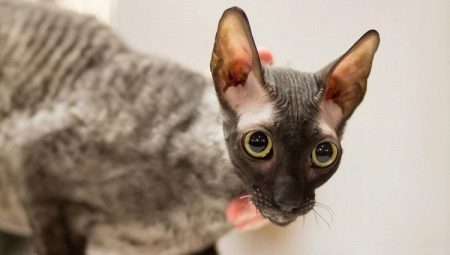In the 1930s, Cornish Rex cats lived in Moravia. Local residents believed that they were sick, and subjected them to destruction.
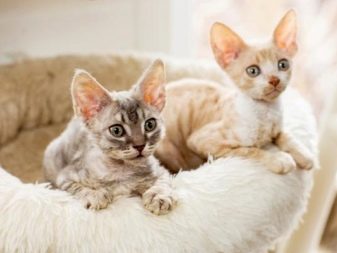
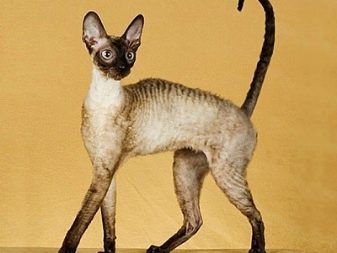
Origin history
The Cornish Rex breed was bred in 1950. The history of its origin is very interesting. In Cornwall County, a farmer’s woman, Nina Ennismore, brought Serena a kitten, including a baby of an unusual appearance. Nature rewarded him with curly hair, a thin and flexible body and a wedge-shaped head.
The cat had very big ears, which made him look like an unearthly creature, and they called it strange - Callibanker. Since at that time village cats, inhabitants of English farms, basically differed from each other only in color, Miss Ennismore, looking at the cat, decided to castrate an adult pet, almost depriving us of the breed of these amazing cats.
The veterinarian, to whom Nina brought an adult cat, had good knowledge of genetics and saw the beginning of a new breed in Callibanker. Taking into account the doctor’s advice on breeding cats, Miss Ennismore went to the breeders A.K. Jude and B. Stirling-Webb - they were known at that time and had great authority and a good reputation in the field of breeding. The veterinarian's words that Callibanker will be the first in the feline family to be different from those recorded in nature were confirmed by Dr. Jude.

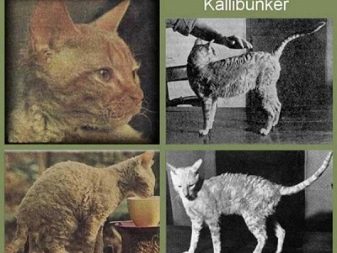
Now Nina Ennismore's duty was to breed a new breed, the name of which she came up with - Cornish Rex.The beginning of the name of the breed indicated the area where the kitten appeared, and the second part of the name of the breed determined the type of activity of Miss Ennismore (she was the mistress of the farm for breeding rabbits with curly hair of Astrex breed). Scientists-breeders were asked to control the mutation of Callibanker for stability, and when the cat reached puberty, he was connected with his mother - a cat Serena, not distinguished by its natural beauty and breed.
After a while, three small kittens were born, two of them had the same curly hair and unusual appearance as Callibanker. Of the two "astrakhan" survivors, there was only one cat, later he was named Polda.
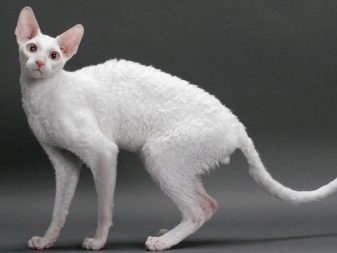

From year to year, Miss Ennismore continued her crossbreeding experiments, in this case fixing the correspondence of “astrakhan” to smooth-haired kittens. Compliance was 55% in the direction of "curly-haired". The properties typical for this breed were preserved provided that the female and the male were carriers of "astrakhan" wool. But after 6 years of breeding, Nina Ennismore began to have problems with finances.
Growing and keeping animals has become difficult. The very first cats, Serena and Kallibaker, suffered a terrible fate - earlier beloved cats were euthanized at the request of the mistress of Miss Nina Ennismore. The Cornish Poldu was waiting for a similar fate, but siliconeman B. Stirling-Webb decided to continue work without the help of other employees and bought the cat (however, during the sampling of the biomaterial in the cat's experiments, Polda had a fateful accident - he was neutered).

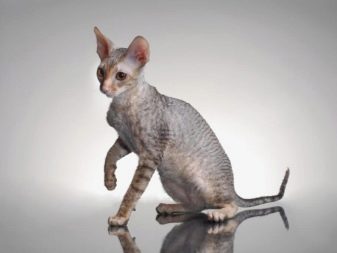
In 1957, an officially registered breed of Cornish Rex cats appeared in England, and in the same year, Francis Blanchery acquired two cats of this breed and moved them from England to the territory of the United States of America. Thus, the "resettlement" of these peculiar animals took place. One of the first animals transported, having a bright red color and called Tabby, did not give offspring.
After some time, a blue cat (her name is Lamorna Cove), already pregnant, was transported to the United States, where she brought offspring of white kittens with a blue tint - two charming Cornish Rex babies. It is worth noting that the father of the kittens was Poldu, who at that moment was not yet neutered.
With this amazing story, the breed of Cornish Rex began in the United States. The lover and breeder of cats Ellen Weiss could not resist the charm of the kids of Lomorna Cove, she bought a cat and called him Marmaduke (in the future, other lines of Cornish Rex breeds went from him).
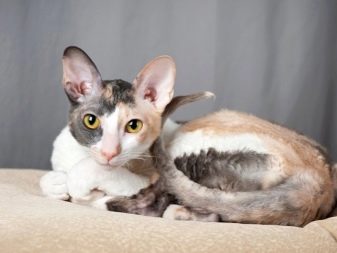

In an effort to engage in breeding work more actively, Miss Weiss decided to get acquainted with the then-known Nina Ennismore, with whom she wanted to conclude an agreement on a profitable deal for breeding the breed, but Miss Ennismore managed to get rid of her “farm” by that period, which she regretted afterwards , since the money proposed by Ellen Weiss could fully compensate for all the costs of animals more than.
Once again, cats of this breed were at risk of extinction. In order to somehow prevent the disappearance of the breed, they were crossed among themselves. Subsequently, North American shorthair cats, as well as Siamese and Burmese, became the genetic material for this.
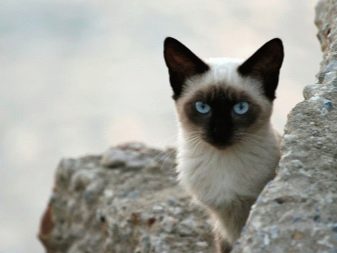

During selection, small changes occurred in the breed, however, at the same time, a wide variety of their color schemes and colors appeared.
You should know that now crossing relatives of Cornish Rex is strictly prohibited.
To date, cats have gained immense popularity due to their external aristocratic appearance and boundless love and affection for their master.

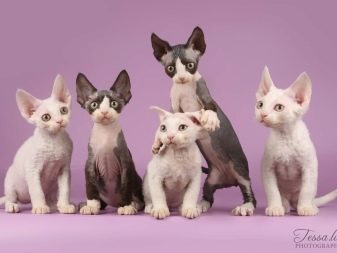
Description
Common Cornish Rex Cat Standards:
- a distinctive feature of the breed is pronounced aristocracy;
- cats have short "astrakhan" hair, which has no outer hair;
- the head is oval;
- the muzzle looks like a small wedge, the forehead smoothly passes into the nose of the Roman type, which is vertically in line with the chin;
- the ears are quite high, wide and large at the base of the head;
- the eye incision is oval, the eyes are inclined upward, pigmentation of the iris corresponds to the color of the cat's coat;
- jaws strong, bite straight;
- cheekbones are high, the chin is quite pronounced;
- the neck conquers with its grace, but rather long and muscular;
- the body is muscular, long, taut;
- limbs graceful, muscular;
- the tail is long, tapering towards the end, flexible, similar to a whip.
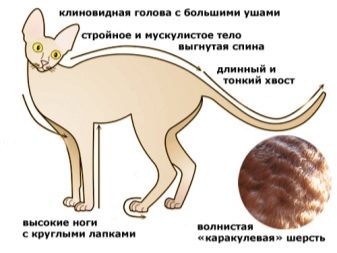
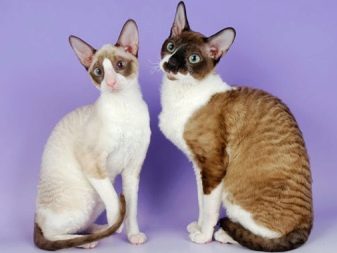
Brief description of an adult cat:
- average growth of 23-27 cm;
- weight - from 3 to 5 kg;
- adult cats are much larger than females.
Popular colors of kittens:
- white: golden or blue eyes, paw pads and pink nose;
- the black: this color is always saturated, eyes are golden, nose and pads on the legs are black;
- chocolate: dark eyes, paw pads and dark nose;
- redhead: golden eyes, paw pads and nose pink;
- grey: Golden eyes, nose and paw pads are also gray.

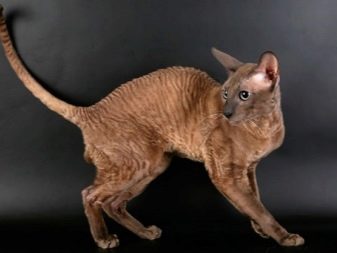
Character Features
Cornish Rex is very active, inquisitive, cheerful. They are sophisticated intellectuals, their character is flexible and soft. These cats are neither vindictive nor dirty, but very attached to the owner. A tail wagging like a dog shows increased susceptibility. Feeling the mood of the owner, they know how to behave in any situation. Very obedient, learn simple commands. They can walk on a harness, and, like dogs, bring small toys during training.
Cornish are considered very active. They will never bask in the sun or “roll” on the couch, like other cats do. Animals love to explore the area (albeit known from feline childhood) and will never ignore a rustling newspaper forgotten in a chair or a sparrow sitting by an open window.
Try to remove the more valuable and necessary things from your sight, because the object, whatever it is, will be regarded by Rex as a new game. In any case, you need to be able to divert the attention of the pet to a cat toy or an abandoned ball.
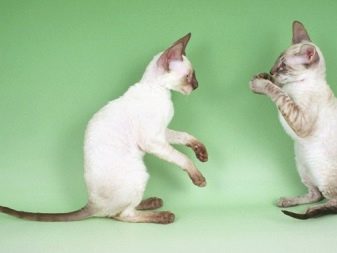

Create mobile game situations in which the roots are “on top”, because these cats are very active and just get so excited about creating a chase.
This breed of cats is slightly annoying and, trying to spin underfoot, makes itself felt with its meow, but feels the mood of its beloved master very well and can give loneliness if a person needs it. In other cases, you will have no time to be bored. Cornish Rex cats are wary of strangers. Keeping a distance is very important for these animals, but they always begin to reduce it first. If the cat feels that the person is not dangerous, he will first allow himself to be stroked, and maybe even he will jump onto your lap.
When purchasing Cornish Rex for a long friendship, you need to remember that this cat breed does not tolerate loneliness. Do not leave the animal for a long time. A prolonged absence of the host can lead to not entirely pleasant consequences. It is not necessary to start birds and rodents with them, because this can awaken the instincts of a wild hunter in them.
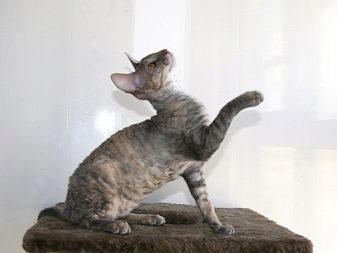
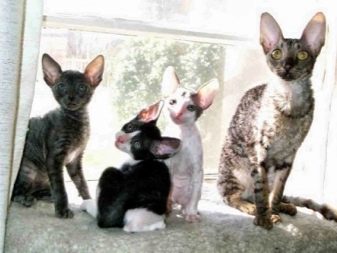
How many live?
Given the good genetics of this breed, the lifespan of these amazing cats is quite long. A lot depends on proper care and nutrition and the attitude of the owners to them. A Cornish Rex cat with good care and maintenance can live 15-20 years.

What to feed?
When the roots are kept, the appearance of fat folds in them should not be allowed, cats should look slim and fit, with well-defined muscles. It should be borne in mind that the caloric content of the cats ’daily diet should correspond to energy needs, as animals lead an active lifestyle, in addition to everything, cats with short hair need a lot of energy to heat their bodies. Servings of food are determined empirically. If the animal does not eat up and looks very thin, you should not limit it to food, you may even need to increase the diet.
When choosing a ready-made balanced diet, wet and dry foods are suitable. It is important to know that this breed is characterized by sensitive digestion.The amount of dry food should not be higher than 1/6 of the total cat's diet. The water in the bowl should be updated twice a day. When feeding natural food, the diet should include 20% of vegetables, cereals and fermented milk products and 80% of meat.


Sample ration:
- feeding vegetables is supposed to be both raw and boiled (carrots, zucchini, pumpkin, cauliflower), they are mixed with meat and given several times a week, sometimes vegetables are changed to cereals;
- dairy (sour-milk) products - kefir, cream give daily + cheese instead of goodies;
- raw yolk with sour cream and cottage cheese is given 2 times a week;
- boiled offal (chicken hearts, liver, kidneys) - once a week;
- boiled chicken (always boneless) - daily;
- raw frozen beef - daily;
Be sure to introduce sprouts of sprouted wheat into the diet, animals are happy to eat them, in addition, this supplement contains a lot of trace elements and vitamins.



There is a separate diet for kittens:
- cereals with the addition of milk give up to 3 months;
- cottage cheese - three times a week;
- whole milk is allowed to be given only up to 5 months;
- they are fed chicken breasts for up to 3.5 months (after which they can be fed chicken legs);
- frozen raw beef is poured with milk, then cut into slices (helps with constipation);
- boiled meat can be mixed with vegetables;
- kittens cannot be fed with one meat or just vegetables;
- 30 grams of beef per day can be given (increase in about 8 months to 120 grams);
- feeding kittens with fish is strictly prohibited.


Due to possible stomach upsets as well as food poisoning, forbid kittens to eat directly from the floor.
How often to feed kittens:
- 1.5-2 months - up to 5 times a day;
- 3-5 months - 4 times;
- 6-7 months - 3 times;
- from 8 months - 2 times.
The kitten in the dishes must always have only clean water. It should be remembered that stale water can cause an upset gastrointestinal tract.
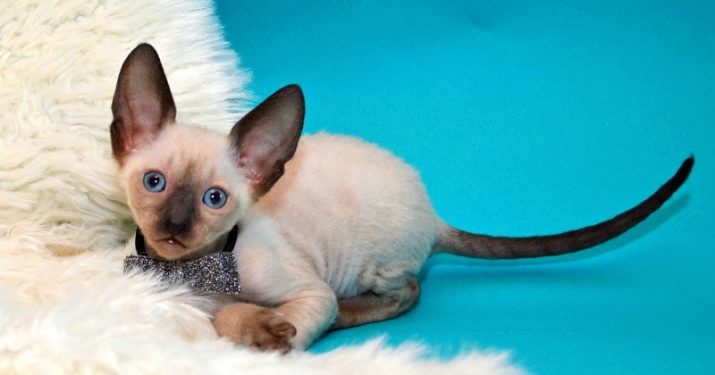
How to care?
To maintain the beauty of the roots, wash 2 times a month. To begin to accustom a kitten to water procedures should be about 16 weeks. The cat needs to be washed with massaging movements along the hair growth. The water temperature should be approximately 38 degrees. After bathing, the wool should be soaked with a towel, but not wiped. If the animal is not afraid of the hair dryer, then you can dry it in a warm mode. To create a "scrawl" on the wool, natural citrus oils are used.
It is often not recommended to comb the corns, as cats of this breed do not fade. When combing, use a mitten or brush with natural bristles so as not to harm the fine coat of the animal.
It is recommended to choose structure-forming shampoos before going to the exhibition, the rest of the time you need to use special zoo shampoos.



Without fail, the claws of the Cornish are cut. In cats, they are quite sharp, in this case it is necessary to constantly ensure that the cat does not spoil the furniture or inadvertently leaves “scratches” on family members. Claws should be trimmed very carefully, only 1-2 millimeters of the transparent part of the claw.
It is necessary to cut with a special nail clipper (its size should be medium). Before the procedure, it is important to treat the tool with a cotton swab with alcohol or an alcohol cloth, then, cutting off the claw, file it, giving a rounded shape. Some breeders use natural cosmetic oil for nails, it protects the cat's claws from exfoliation and moisturizes them.
Check your cat’s teeth weekly and visit your veterinarian if necessary. Cat dental care should be daily. Teeth can be wiped with plantain infusion by wrapping gauze on a finger, or brushing with a rubber thimble. Also in specialized pet stores you can buy toothpaste or a special toy for brushing your teeth. Remember to include solid, healthy teeth in your diet.



For eye care, it is recommended to use simple boiled water and infusion of chamomile once a week (eyes are treated to prevent infectious diseases). The ears of the Rex need constant care. In order to clean them, you must use petroleum jelly or special care drops (clean them with a cotton swab). It is necessary to monitor the ears of the pet in order to prevent ear diseases in time.
The list of necessary items for the care of Cornish Rex:
- cat shampoo;
- claw cutter;
- cotton pads and sticks;
- petroleum jelly;
- special toothpaste and brush for cleaning the teeth of the animal;
- powder for cleaning wool;
- dry shampoo for cleaning wool.

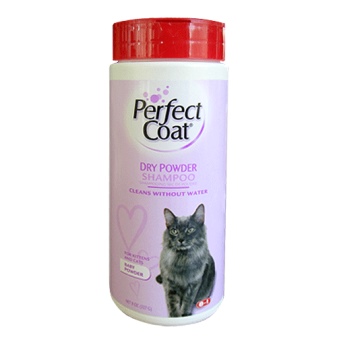
Parenting
Being in the "childhood" age, Cornish Rex cats can be easily trained. If you purchased a kitten, try to draw a line immediately and show what is allowed and what the animal should not do throughout its cat life. You should not punish the animal for a small offense and raise your voice, because in the eyes of a cat you will look big and formidable, but not a source of affection and love.
Rex loves a pleasant company, they like it when they pay a lot of attention and they really like to sit in the arms of family members. Cornish Rex can easily be taught to give a paw, bring small toys, as well as the teams "sit" and "lay".
Cats of this breed calmly walk on a harness on the street and in general, sometimes behave like dogs in their behavior. Animals well know the purpose of the tray and why you need a scratching post, and in this sense you will not have difficulty with them in maintaining comfort and cleanliness in the house. To the owner of this unique animal It is necessary to purchase a cozy and warm cat house. A big game complex of a house and various game elements (claws, ropes) is suitable for active Cornish.
In the absence of the opportunity to establish a cat town, you can get by with a beautiful stylish house or a couch.
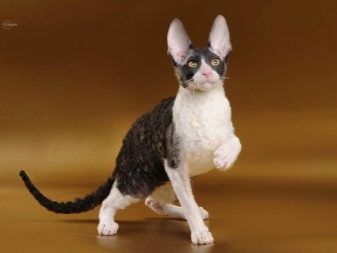
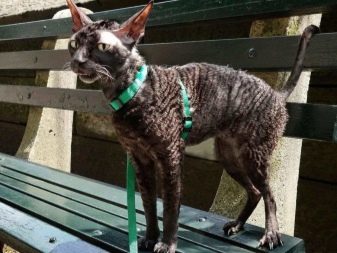
For the contents of the cat, in addition to the bed, you will need:
- cat toilet;
- litter for the toilet (with granules of medium fraction, designed for medium-sized short-haired cats);
- care products (see list above);
- bowls for feeding - 3 pieces (1 intended for water and 2 for food);
- carrying bag (in case of walking, moving or going to the veterinarian);
- cat toys purchased from an animal store;
- medium-sized claw-point;
- high-quality feed;
- first-aid kit (contents individually);
- clothing for cats in the form of a sweater or jacket with a hood (in case of walking.
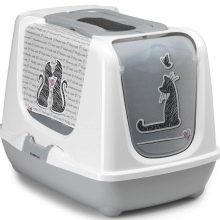
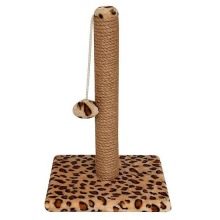

By the way, on a walk, instead of a harness or a carrying bag, these cats like to be placed on the owner’s arms or shoulder (sometimes they climb onto their heads).
This unique breed can perfectly get along in any family:
- with a small child (cats can easily get along with children);
- an elderly couple (cats can cheer them up with their cheerful disposition);
- in a family with allergy sufferers (cats don’t lose their hair even during the molting season).


Health
If you do not intend to breed Cornish Rex, then it is better to sterilize or castrate. Animals can be sterilized and neutered after puberty within 1.5 years of feline life (this is due to the correct formation of the genitourinary system). The operation takes place in a veterinary clinic and usually lasts 15-20 minutes under local or general anesthesia. As a rule, after anesthesia, 24 hours are needed to restore the animal. Try to pay more attention to your beloved pet on this day. If the cat does not undergo anesthesia within 24 hours, be sure to contact the veterinarian where the operation took place.
A female who has not brought kittens and has not undergone sterilization will eventually have health problems, and an uncastrated cat will be able to mark corners in her apartment all her feline life, releasing specific smelling substances in her urine.


Good health is inherent in the Cornish Rex breed, but you should still know that some diseases occur in them.
- Alopecia. At the birth of a kitten, a gentle fluff appears on it, which disappears after two weeks and the animal becomes bald. It happens that the disease affects not only the coat, but even the claws and mustache.
- Atrophy of the eye retina - it is a genetic disease. Unfortunately, the roots are the leaders in this disease. The disease can be established only in a specialized clinic.
- Impaired metabolism. Cornish Rex's similar health troubles can occur due to improper metabolism. Whether the metabolism is impaired, only a veterinarian can determine.
- Hypokalemia - a complex disease consisting in a lack of potassium. The disease is recognized as hereditary and can manifest itself in the baby if the male and female suffered from this ailment.
- "Greasy tail" - occurs due to the strong release of fat from the sebaceous glands that are under the tail. On the coat at the tail, a waxy mass with an unpleasant odor accumulates, inflammatory processes occur, the skin becomes red and wet. In the case of a chronic form of the disease, the tail balds.
It is worth recalling about vaccination: vaccinations given on time will protect the cat from various diseases. And, of course, you must not forget to carry out prevention against helminths.


Breeding
When a female is one year old, she can be knitted with a male, but be sure to skip the first estrus. It is better to start the search for a partner in advance, because it may happen that there is not a suitable “groom” nearby. The necessary contacts can be found in the breeding nursery, but be prepared for the fact that you have to travel to the territory of the cat. It is advisable that this be a short trip, as the road negatively affects the mental and physical condition of the pregnant cat.
If you decide to breed kittens, you must:
- draw up documents for the cat confirming the pedigree;
- get a description of the animal from the club felinologist;
- find a partner;
- with the owners of the "groom" to draw up an agreement;
- in the club to take a document for registration of binding;
- show the cat to the veterinarian, check for vaccinations and treat for parasites;
- be sure to trim the claws to avoid scratching the partner.
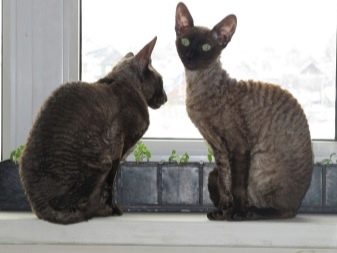

An important point: the cat must not be the first mating (the more experienced the male, the greater the guarantee that everything will be successful).
Provided that the cat suits you, the female is usually brought to him on the second day after the onset of estrus and left in the cat for 3-8 days. The most ideal time for fertilization will be the second and fourth day. Animals do not need to interfere with mating, everything should happen naturally. If in the morning you notice the calm behavior of the female, which lets the cat come to her and “rolls” on the back on the floor, consider that everything went well.
Usually the pregnancy is calm and lasts about 65 days. Delivery is possible a little earlier and a little later (+/- two days). Childbirth ends with the appearance of "astrakhan" kittens from 4 to 5 babies. Babies are excommunicated from the cat at 2.5 months. As a rule, the owners of the "groom" at the birth of kittens take one baby for themselves, but it may happen that for mating you will have to pay a certain amount in cash.
Cornish Rex cat is able to bring litter 3-4 times a year, but too frequent births are undesirable, because they require a lot of strength from her. In order for a cat to bring healthy litter, she herself must be healthy and have the strength to recover. In order for the female’s body to recover, it will be ideal if 1-2 years pass after the birth.

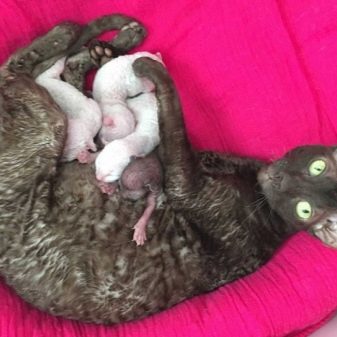
Owner reviews
Given the feedback from owners of cats and cats of the breed Cornish Rex, we can draw certain conclusions:
- the roots are responsive and do not like to upset their owners;
- they are smart, affectionate, sociable, playful;
- do not fade, their hair is pleasant to the touch;
- love children, complaisant, devoted;
- kind to others;
- amenable to training;
- intellectuals.
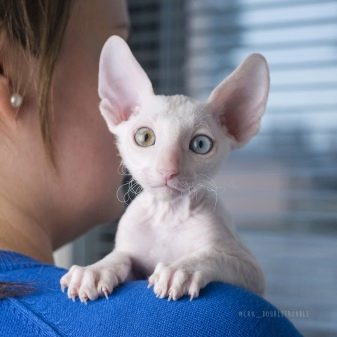
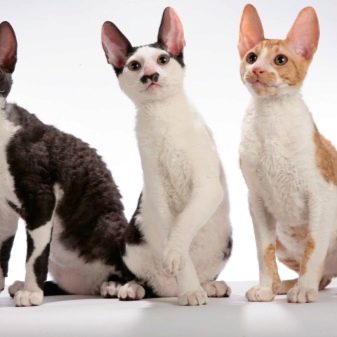
The disadvantages of Cornish Rex cats, according to the owners.
- In the first year of a pet’s life in the house, it can be annoying with frequent meowing, especially if the animal is often left alone (the loyalty of these cats “rolls over”).
- He cannot stand the competition in the house.
- Some cats are prone to overeating. Be sure to ensure that the pet does not overeat.
- A specific smell is peculiar (in some individuals, secretion is secured between the paw pads, not everyone may like it).
- Constant craving for heat (this is due to the fact that the animal is short-haired, in connection with which the temperature of its body is elevated, so the cats have to look for warm places). For a private house and a cold apartment, such cats are not suitable.
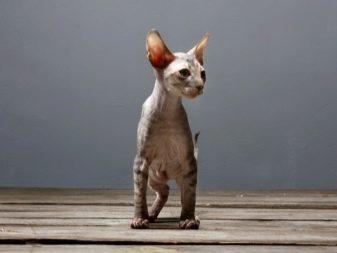
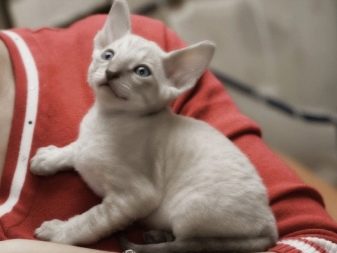
With all this, you need to understand that you can meet Cornish Rex, who will not have such negative qualities. All cats are very individual in character, however, there are common features inherent in the breed. For this reason, before acquiring such an animal, it is recommended that you think about whether you can put up with its imperfections. But here it is necessary to recognize that any breed has flaws. You should also know that Cornish Rex is more susceptible to disease if taken from the hands, and not from the nursery.
It is very important to determine what specific intention you pursue when choosing a cat, what you expect from it in the future (for example, suppose you want to get a reliable assistant in the fight against rodents, but this does not apply in any way to the Cornish Rex breed). For most potential owners, an important point in the process of choosing a cat is its origin.
It is especially important to take into account not only our own desires and preferences, but also the availability of financial opportunities, since our smaller brothers with excellent pedigree are often simply not affordable for a middle-income buyer.
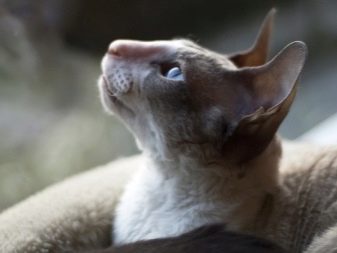
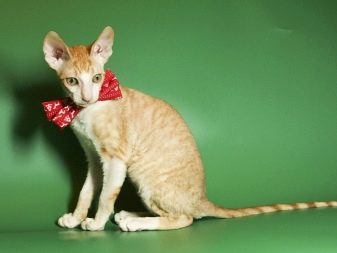
Of particular importance may be how old your pet will be. Some cat lovers think that buying an adult cat rather than a baby is considered the best solution. For people who live calmly and measuredly, in some cases it’s quite difficult to deal with a kitten, since it needs to be fed very often, pay more attention while caring for it, because with the restless character of the baby, he will “rush around”, turning over with somersault, and to demolish everything that comes in his way.
Mature Cornish Rex is often also characterized by a very cheerful disposition and playfulness, but still they are much more balanced than baby kittens. Of course, if you nevertheless decided to acquire adult animals, then in the future you will not need to come into conflict with the difficulties of his training in the toilet. An animal with a pedigree should be purchased if you intend to really take part in various exhibitions, so that after that you can be proud of your pet.
If you are deprived of vanity and you need an animal as a close friend, then there is no difference with the pedigree "your little brother" or not. The main thing is those important feelings that your beloved pet will give you to experience.
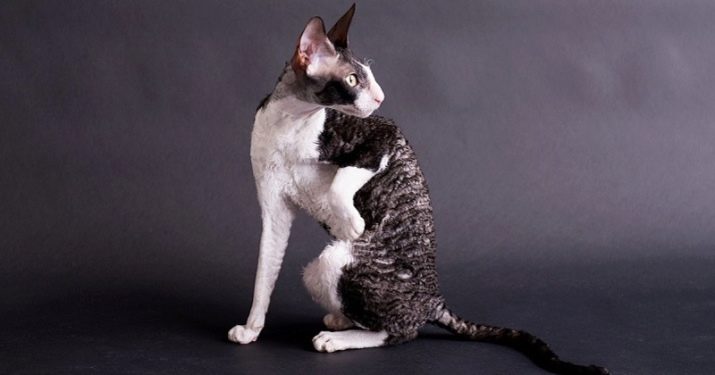
About the features of Cornish Rex cats, see the next video.
